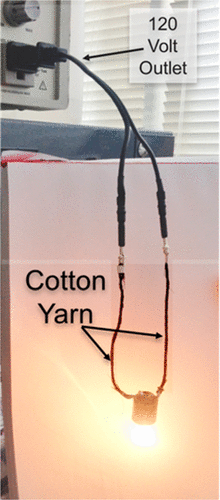当前位置:
X-MOL 学术
›
Acc. Chem. Res.
›
论文详情
Our official English website, www.x-mol.net, welcomes your feedback! (Note: you will need to create a separate account there.)
Melding Vapor-Phase Organic Chemistry and Textile Manufacturing To Produce Wearable Electronics
Accounts of Chemical Research ( IF 18.3 ) Pub Date : 2018-03-09 00:00:00 , DOI: 10.1021/acs.accounts.7b00604 Trisha L. Andrew 1, 2 , Lushuai Zhang 1 , Nongyi Cheng 3 , Morgan Baima 1 , Jae Joon Kim 1, 4 , Linden Allison 1 , Steven Hoxie 1
Accounts of Chemical Research ( IF 18.3 ) Pub Date : 2018-03-09 00:00:00 , DOI: 10.1021/acs.accounts.7b00604 Trisha L. Andrew 1, 2 , Lushuai Zhang 1 , Nongyi Cheng 3 , Morgan Baima 1 , Jae Joon Kim 1, 4 , Linden Allison 1 , Steven Hoxie 1
Affiliation

|
Body-mountable electronics and electronically active garments are the future of portable, interactive devices. However, wearable devices and electronic garments are demanding technology platforms because of the large, varied mechanical stresses to which they are routinely subjected, which can easily abrade or damage microelectronic components and electronic interconnects. Furthermore, aesthetics and tactile perception (or feel) can make or break a nascent wearable technology, irrespective of device metrics. The breathability and comfort of commercial fabrics is unmatched. There is strong motivation to use something that is already familiar, such as cotton/silk thread, fabrics, and clothes, and imperceptibly adapt it to a new technological application.(24) Especially for smart garments, the intrinsic breathability, comfort, and feel of familiar fabrics cannot be replicated by devices built on metalized synthetic fabrics or cladded, often-heavy designer fibers. We propose that the strongest strategy to create long-lasting and impactful electronic garments is to start with a mass-produced article of clothing, fabric, or thread/yarn and coat it with conjugated polymers to yield various textile circuit components. Commonly available, mass-produced fabrics, yarns/threads, and premade garments can in theory be transformed into a plethora of comfortably wearable electronic devices upon being coated with films of electronically active conjugated polymers. The definitive hurdle is that premade garments, threads, and fabrics have densely textured, three-dimensional surfaces that display roughness over a large range of length scales, from microns to millimeters. Tremendous variation in the surface morphology of conjugated-polymer-coated fibers and fabrics can be observed with different coating or processing conditions. In turn, the morphology of the conjugated polymer active layer determines the electrical performance and, most importantly, the device ruggedness and lifetime. Reactive vapor coating methods allow a conjugated polymer film to be directly formed on the surface of any premade garment, prewoven fabric, or fiber/yarn substrate without the need for specialized processing conditions, surface pretreatments, detergents, or fixing agents. This feature allows electronic coatings to be applied at the end of existing, high-throughput textile and garment manufacturing routines, irrespective of dye content or surface finish of the final textile. Furthermore, reactive vapor coating produces conductive materials without any insulating moieties and yields uniform and conformal films on fiber/fabric surfaces that are notably wash- and wear-stable and can withstand mechanically demanding textile manufacturing routines. These unique features mean that rugged and practical textile electronic devices can be created using sewing, weaving, or knitting procedures without compromising or otherwise affecting the surface electronic coating. In this Account, we highlight selected electronic fabrics and garments created by melding reactive vapor deposition with traditional textile manipulation processes, including electrically heated gloves that are lightweight, breathable, and sweat-resistant; surface-coated cotton, silk, and bast fiber threads capable of carrying large current densities and acting as sewable circuit interconnects; and surface-coated nylon threads woven together to form triboelectric textiles that can convert surface charge created during small body movements into usable and storable power.
中文翻译:

融合汽相有机化学和纺织品制造以生产可穿戴电子产品
身体可安装的电子产品和电子活动服装是便携式交互式设备的未来。但是,可穿戴设备和电子服装是苛刻的技术平台,因为它们通常会承受很大的变化的机械应力,这很容易磨损或损坏微电子组件和电子互连。此外,无论设备指标如何,美学和触觉感知(或感觉)都可以制造或破坏新生的可穿戴技术。商业织物的透气性和舒适性是无与伦比的。有强烈的动机去使用已经熟悉的东西,例如棉/丝线,织物和衣服,并使其潜移默化地适应新技术的应用。(24)特别是对于智能服装,其固有的透气性,舒适性,并且熟悉的织物的感觉无法通过在金属化合成织物或覆层且经常较重的名牌纤维上构建的设备来复制。我们建议,制造持久且有影响力的电子服装的最强策略是从大量生产的衣服,织物或线/纱开始,并在其上涂上共轭聚合物以生产各种纺织电路组件。从理论上讲,通常可用的批量生产的织物,纱线/线和预制服装可以在涂有电子活性共轭聚合物薄膜后转变为大量舒适可穿戴的电子设备。最终的障碍是,预制的服装,线和织物具有致密的三维表面,这些表面在从微米到毫米的各种大范围的长度范围内都显示出粗糙度。在不同的涂覆或加工条件下,可以观察到共轭聚合物涂覆的纤维和织物的表面形态发生巨大变化。反过来,共轭聚合物活性层的形态决定了电性能,最重要的是,决定了器件的耐用性和寿命。反应性蒸汽涂覆方法允许将共轭聚合物薄膜直接形成在任何预制服装,预制织物或纤维/纱线基材的表面上,而无需特殊的加工条件,表面预处理,洗涤剂或固定剂。此功能允许在现有的高通量纺织品和服装制造程序的结尾处施加电子涂层,而不管最终纺织品的染料含量或表面光洁度如何。此外,反应性蒸气涂层可产生没有任何绝缘部分的导电材料,并在纤维/织物表面上产生均匀且保形的薄膜,这种薄膜具有明显的耐洗和耐磨损性能,并且可以承受机械要求苛刻的纺织品生产程序。这些独特的功能意味着可以使用缝纫,编织或编织程序创建坚固实用的纺织电子设备,而不会影响或影响表面电子涂层。在此帐户中,我们重点介绍了通过将反应性气相沉积与传统的纺织品处理过程融合在一起而制成的精选电子织物和服装,包括轻巧,透气和防汗的电加热手套;表面涂层的棉,丝绸,韧皮纤维线能够承载大电流密度并用作可缝制的电路互连;和表面涂层的尼龙线编织在一起形成摩擦纺织物,可以将在小身体运动过程中产生的表面电荷转化为可用的和可存储的能量。
更新日期:2018-03-09
中文翻译:

融合汽相有机化学和纺织品制造以生产可穿戴电子产品
身体可安装的电子产品和电子活动服装是便携式交互式设备的未来。但是,可穿戴设备和电子服装是苛刻的技术平台,因为它们通常会承受很大的变化的机械应力,这很容易磨损或损坏微电子组件和电子互连。此外,无论设备指标如何,美学和触觉感知(或感觉)都可以制造或破坏新生的可穿戴技术。商业织物的透气性和舒适性是无与伦比的。有强烈的动机去使用已经熟悉的东西,例如棉/丝线,织物和衣服,并使其潜移默化地适应新技术的应用。(24)特别是对于智能服装,其固有的透气性,舒适性,并且熟悉的织物的感觉无法通过在金属化合成织物或覆层且经常较重的名牌纤维上构建的设备来复制。我们建议,制造持久且有影响力的电子服装的最强策略是从大量生产的衣服,织物或线/纱开始,并在其上涂上共轭聚合物以生产各种纺织电路组件。从理论上讲,通常可用的批量生产的织物,纱线/线和预制服装可以在涂有电子活性共轭聚合物薄膜后转变为大量舒适可穿戴的电子设备。最终的障碍是,预制的服装,线和织物具有致密的三维表面,这些表面在从微米到毫米的各种大范围的长度范围内都显示出粗糙度。在不同的涂覆或加工条件下,可以观察到共轭聚合物涂覆的纤维和织物的表面形态发生巨大变化。反过来,共轭聚合物活性层的形态决定了电性能,最重要的是,决定了器件的耐用性和寿命。反应性蒸汽涂覆方法允许将共轭聚合物薄膜直接形成在任何预制服装,预制织物或纤维/纱线基材的表面上,而无需特殊的加工条件,表面预处理,洗涤剂或固定剂。此功能允许在现有的高通量纺织品和服装制造程序的结尾处施加电子涂层,而不管最终纺织品的染料含量或表面光洁度如何。此外,反应性蒸气涂层可产生没有任何绝缘部分的导电材料,并在纤维/织物表面上产生均匀且保形的薄膜,这种薄膜具有明显的耐洗和耐磨损性能,并且可以承受机械要求苛刻的纺织品生产程序。这些独特的功能意味着可以使用缝纫,编织或编织程序创建坚固实用的纺织电子设备,而不会影响或影响表面电子涂层。在此帐户中,我们重点介绍了通过将反应性气相沉积与传统的纺织品处理过程融合在一起而制成的精选电子织物和服装,包括轻巧,透气和防汗的电加热手套;表面涂层的棉,丝绸,韧皮纤维线能够承载大电流密度并用作可缝制的电路互连;和表面涂层的尼龙线编织在一起形成摩擦纺织物,可以将在小身体运动过程中产生的表面电荷转化为可用的和可存储的能量。



























 京公网安备 11010802027423号
京公网安备 11010802027423号